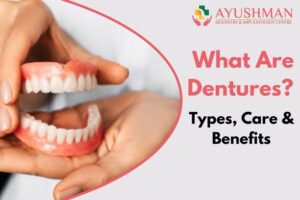What to Know About a Crossbite?

What to Know About a Crossbite?
Do you ever notice your teeth not lining up properly when you bite down? This could be a sign of a crossbite, a common dental issue. Here’s what you should understand about crossbites.
What is a Crossbite?
Imagine your teeth like puzzle pieces. In a healthy bite, the upper teeth fit slightly over the lower teeth. With a crossbite, some upper teeth land behind the lower teeth instead. This misalignment can affect just one tooth or a whole group, either in your mouth’s front (anterior) or back (posterior).
Types of Crossbites:
- Posterior Crossbite: This is more common, affecting the back teeth. Here, the upper molars fit inside the lower molars, almost leaning inwards.
- Anterior Crossbite: This involves the front teeth. One or more upper front teeth bite behind the lower front teeth. This differs from an underbite, where all your upper teeth are behind the lower ones.
What Causes a Crossbite?
Several factors can contribute to a crossbite:
- Habits: Thumb sucking, finger sucking, or pacifier use can push teeth out of place.
- Tongue Thrusting: Pushing your tongue against your teeth during swallowing can cause misalignment.
- Missing Teeth: Gaps left by missing teeth can cause other teeth to shift.
- Baby Teeth Issues: Retained baby teeth or early loss can disrupt proper adult tooth eruption.
- Jaw Problems: A small jaw may not have enough space for all your teeth, or teeth may be too big for proper alignment.
- Genetics: Some people inherit a predisposition to crossbites.
- Cleft Lip or Palate: These birth defects can affect jaw development and tooth alignment.
- Mouth Breathing: Breathing through your mouth instead of your nose can impact jaw growth.
Signs and Symptoms:
The main clue is misaligned teeth. Depending on the severity, you might see:
- One tooth slightly tucked behind another
- Several teeth not meeting properly
- Loose teeth
- Receding gums
- Uneven wear and tear on teeth
- Difficulty chewing or biting
Why Early Treatment Matters
Left untreated, crossbites can lead to more problems:
- Increased tooth wear, cavities, and enamel breakdown
- Uneven jaw growth and shifting
- Unbalanced facial features
- Jaw joint problems (TMJ)
Early intervention is key, especially during childhood when the jaw and face are still developing. This allows for easier correction and prevents future complications.
Treatment Options:
Orthodontists are specialists trained in correcting bite problems. Treatment depends on the type and severity of your crossbite. Here are some common approaches:
- Palatal Expanders: These appliances widen your upper jaw to create space for proper tooth alignment.
- Braces: Traditional braces apply gentle pressure to move teeth into the correct positions. You might use an expander alongside braces.
- Removable Appliances: For mild anterior crossbites, a spring-loaded appliance can push an upper front tooth forward.
- Clear Aligners: In some cases, clear plastic aligners can gradually move teeth into place.
- Habit Correction: Stopping habits like thumb sucking may involve using a fixed palatal crib appliance or myofunctional therapy to train proper tongue and swallowing habits.
Final Note
A crossbite isn’t an emergency, but early treatment is recommended to avoid future problems with your teeth, jaws, and facial features. If you notice any misalignment in your child’s teeth or have concerns about your bite, talk to your dentist or orthodontist. They can assess the situation and recommend the best course of action for a healthy, beautiful smile.









